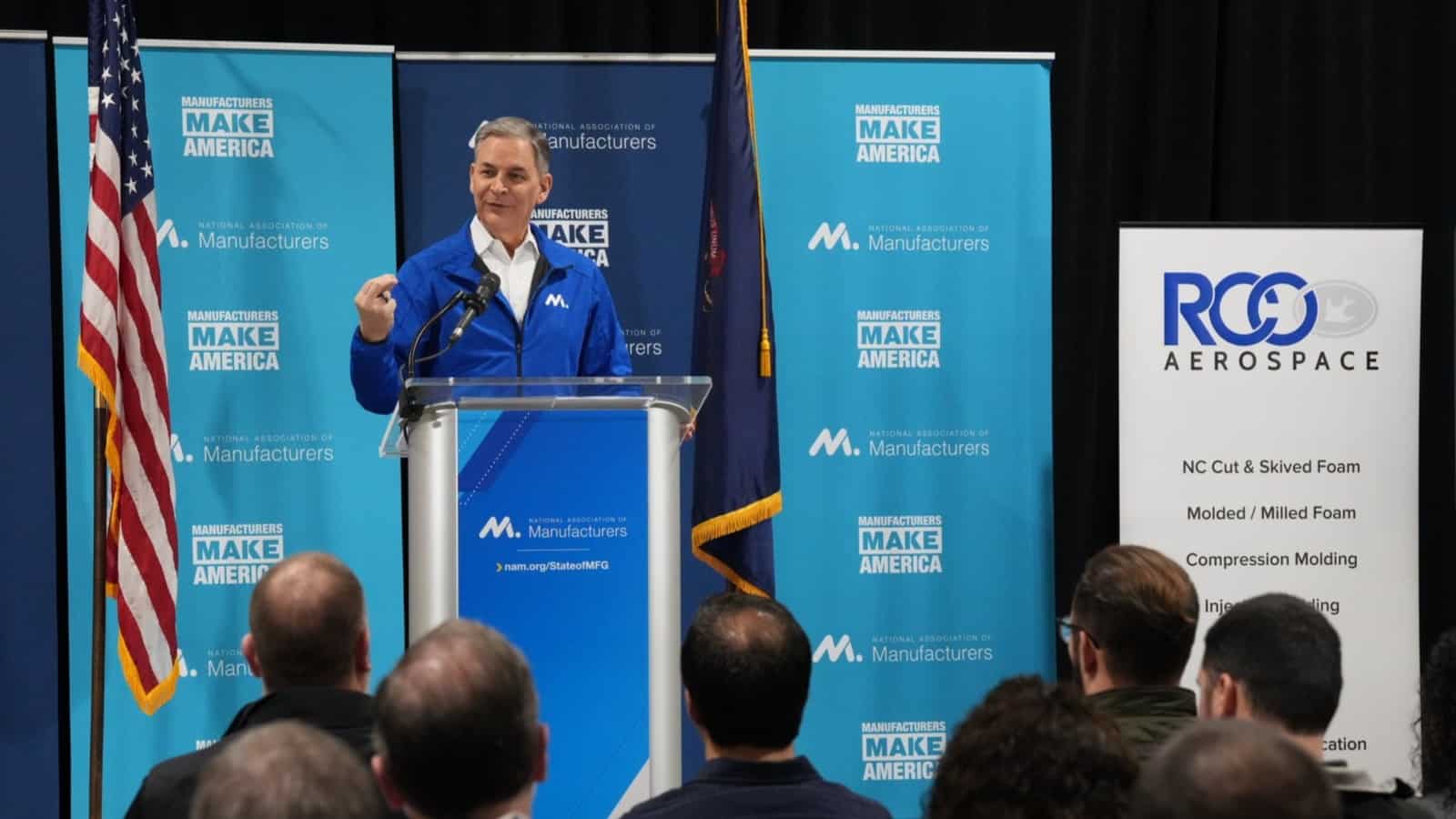Manufacturers Score Victory on Proxy Firms

The NAM achieved a significant victory in court Wednesday in a case that sought to bring needed oversight to proxy advisory firms—and, more broadly, to ensure regulatory certainty for manufacturers.
The background: Proxy firms make recommendations regarding the way shareholders should vote on proxy ballot proposals that come before public companies.
- These firms operate with minimal oversight despite their outsized influence and even though their decisions can have significant and sometimes harmful impacts.
The fight: In 2020, the Securities and Exchange Commission finalized an NAM-backed rule that included a range of modest but critical reforms to proxy firms’ business models.
- In particular, the 2020 rule ensured that companies had more information about the firms’ voting recommendations and provided investors with companies’ responses to those recommendations.
- But in 2022, the SEC rescinded critical portions of that rule.
- The NAM sued the SEC, asking the U.S. Court of Appeals for the Fifth Circuit to strike down this arbitrary and capricious agency action.
The victory: This week—in news covered by Reuters, POLITICO Pro (subscription), Law360 (subscription), Pensions & Investments (subscription) and Bloomberg (subscription)—the Fifth Circuit ruled in the NAM’s favor, deciding that the SEC acted unlawfully in rescinding the 2020 rule. In particular, the court made two critical points:
- The court held that the SEC’s stated justification for its decisions to rescind NAM-supported proxy firm reforms didn’t pass muster and called the agency’s reasoning “facially irrational” and not “reasonable [or] reasonably explained.”
- The court also ruled that a government agency reversing course despite no change in its underlying factual findings must “explain its about-face” by “giv[ing] a more detailed explanation” than the SEC provided.
- This ruling builds on existing case law that prevents agencies from arbitrarily reversing policies after administrations change, thus encouraging regulatory certainty for manufacturers.
Our take: “This decision confirms that federal agencies are bound by the rule of law, even as administrations change,” said NAM Chief Legal Officer Linda Kelly.
- “Manufacturers depend on the SEC to be a steady regulatory hand at the wheel of America’s world-leading capital markets—an obligation the agency abandoned in rescinding the commonsense, compromise 2020 proxy advisory firm rule. … We will continue to fight in court to uphold the 2020 rule—and to work with the SEC and with Congress to ensure appropriate oversight of these powerful actors.”
NAM, ACC Challenge EPA’s National Drinking Water Rule

The NAM and the American Chemistry Council yesterday filed a petition challenging the Environmental Protection Agency’s first-ever national drinking water standard limiting the presence of six types of per- and polyfluoroalkyl substances, or PFAS.
What’s going on: The organizations are seeking to overturn the final rule—issued in April by the EPA—in the D.C. Circuit Court of Appeals on the grounds that it exceeds the agency’s authority under the Safe Drinking Water Act of 1974 and “is arbitrary, capricious and an abuse of discretion,” in violation of the Administrative Procedure Act.
- Under the rule, PFAS in municipal water systems are limited to near-zero levels. Systems nationwide will have three years to monitor for the chemicals and two subsequent years to install technology to reduce the compounds’ levels in the water.
- The water systems will (and, in fact, have already begun to) sue manufacturers to cover their costs. Meanwhile, plaintiffs’ attorneys are using the standard in product liability and greenwashing suits against manufacturers.
- PFAS are a diverse group of chemicals that have been used widely for decades due to their unique ability to douse fires and resist grease, stains and corrosion. Today they’re a key component in a wide range of critical products, from semiconductors, to the components of the electrical grid, to renewable-energy production equipment.
Why it’s problematic: The final regulation of PFAS “is wholly infeasible and threatens these vital substances’ continued application in manufacturing processes,” said NAM Chief Legal Officer Linda Kelly, adding that the agency’s rulemaking is based “on a deeply flawed cost-benefit analysis” and fails to follow Safe Drinking Water Act procedure and other statutory requirements.
- “In many instances, there is no viable alternative for these chemicals, and companies may be forced to change plans dramatically” to follow the new rule, NAM Managing Vice President of Policy Chris Netram said in April.
- “In everyday life, including emergency situations like a fire or operating room circumstance, there’s a real reliance on these products—it’s not just about job losses and costs but fundamental decisions that have widespread ramifications,” Netram added recently.
What should be done: The rule should be vacated as soon as possible, the NAM and the ACC told the court.
Thermo Fisher Scientific Helps Manufacturers with PFAS Testing

As government regulation of per- and polyfluoroalkyl substances ramps up worldwide, Thermo Fisher Scientific is seeing a boom in its PFAS testing business.
“We’ve seen an increase in demand from a number of countries in the Americas and in Europe,” said Toby Astill, director of environmental and food safety in chromatography and mass spectrometry at the life sciences giant. “Those regions are driving more discussions around current and future regulations than other regions.”
- In recent weeks, the Environmental Protection Agency has issued several final rules concerning PFAS. These include the first-ever national regulation limiting PFAS in drinking water to near-zero levels and, just last week, the designation of two PFAS chemicals as hazardous substances under the Superfund law.
Writing is on the wall: Thermo Fisher foresaw the need for comprehensive PFAS analysis early on. That’s why it’s been offering clients a full suite of testing capabilities for more than a decade.
- Commonly called “forever chemicals” because they do not break down easily in the environment, PFAS were used widely in everyday products starting in the 1940s, owing to their ability to put out fires and resist grease, corrosion and stains in addition to countless other consumer and industrial applications.
- Using chromatography—“technology that allows lab users to separate and analyze the different components in samples,” according to Astill—Thermo Fisher can “confirm the presence of a specific substance and determine how much is there.”
- The tech is not limited to PFAS, however; it can also detect, down to parts per trillion, the presence of pesticides, heavy metals and other substances, Astill said. And it works on samples of almost anything, including food packaging, water and even air.
Aiding compliance: In coming years, manufacturers may need to analyze their PFAS exposure comprehensively to remain compliant with Toxic Substances Control Act and other international regulations, including those from the EPA, Astill said.
- In 2021, the EPA released its PFAS Strategic Roadmap, addressing the entire lifecycle of PFAS.
- Early last year, the agency proposed the first federal limits on PFAS, instituting maximum allowable levels for six substances in drinking water.
- In January, it finalized an “inactive PFAS” rule, mandating that any company wishing to manufacture or import PFAS chemicals that haven’t been made in years must first get approval from the EPA.
- That’s where testing comes in. “Manufacturers will want to figure out their [level of] PFAS exposure—whether it’s from their supply chains or the products they’re making,” Astill went on. “Because we see an evolving regulatory landscape, manufacturers need to have a baseline of where they are today, in 2024. That way they’re more prepared for regulatory compliance, and if needed, can review data retrospectively to understand trends. In fact, in October 2023, the EPA issued a mandatory one-time reporting rule on most PFAS manufactured or imported into the U.S. since 2011.”
- This February, the EPA proposed two regulations under the Resource Conservation and Recovery Act that added nine PFAS to the list of RCRA hazardous constituents with superfund implications.
Smart legislation: Thermo Fisher recognizes that we still have much to learn about PFAS chemicals, including whether many of them are harmful in the first place and whether there are practicable alternatives. In light of the many unknowns, the company recommends that legislators take a judicious approach to their regulation.
- “We don’t yet know everything about PFAS or all the PFAS” in existence, said Astill. “We need longer-term studies so we understand what we need to regulate and what we need to measure—be it in manufacturing materials or water—before we start regulating more.”
- Forthcoming regulations should also take into account the difficulty and expense of implementing PFAS remediation solutions, she added. “Legislators and regulators should consider the fact that this is not an easy feat for companies.”
Working on an alternative: While Thermo Fisher is not involved directly in inventing alternatives to PFAS, it is working actively with organizations that are doing just that, and it’s optimistic about the outcomes.
- “It’s [been] very difficult to find something with equal properties that is less of a potential health and environmental issue,” Astill said. “But what we have is a lot of intelligent global groups collaborating to share testing data and understand what potential replacement materials make sense—and that’s a tremendous opportunity.”
Thermo Fisher Scientific Helps Manufacturers with PFAS Testing

As government regulation of per- and polyfluoroalkyl substances ramps up worldwide, Thermo Fisher Scientific is seeing a boom in its PFAS testing business.
“We’ve seen an increase in demand from a number of countries in the Americas and in Europe,” said Toby Astill, director of environmental and food safety in chromatography and mass spectrometry at the life sciences giant. “Those regions are driving more discussions around current and future regulations than other regions.”
- In recent weeks, the Environmental Protection Agency has issued several final rules concerning PFAS. These include the first-ever national regulation limiting PFAS in drinking water to near-zero levels and, just last week, the designation of two PFAS chemicals as hazardous substances under the Superfund law.
Writing is on the wall: Thermo Fisher foresaw the need for comprehensive PFAS analysis early on. That’s why it’s been offering clients a full suite of testing capabilities for more than a decade.
- Commonly called “forever chemicals” because they do not break down easily in the environment, PFAS were used widely in everyday products starting in the 1940s, owing to their ability to put out fires and resist grease, corrosion and stains in addition to countless other consumer and industrial applications.
- Using chromatography—“technology that allows lab users to separate and analyze the different components in samples,” according to Astill—Thermo Fisher can “confirm the presence of a specific substance and determine how much is there.”
- The tech is not limited to PFAS, however; it can also detect, down to parts per trillion, the presence of pesticides, heavy metals and other substances, Astill said. And it works on samples of almost anything, including food packaging, water and even air.
Aiding compliance: In coming years, manufacturers may need to analyze their PFAS exposure comprehensively to remain compliant with Toxic Substances Control Act and other international regulations, including those from the EPA, Astill said.
Read the full story here.
PFAS CERCLA Designation Will Harm Manufacturing

In a move that will hinder the growth of manufacturing in the U.S., according to the NAM, the Environmental Protection Agency on Friday designated two widely used chemicals as hazardous substances under the Comprehensive Environmental Response, Compensation and Liability Act, or Superfund law, Law360 (subscription) reports.
What’s going on: The addition of two per- and polyfluoroalkyl substances, or PFAS, to the federal list “means the EPA can investigate and clean up releases of the chemicals and ensure that leaks, spills and other releases are reported. Under CERCLA, the government and other parties can sue for contributions to cleanups and to recover costs related to those actions.”
- The newly added PFAS are perfluorooctanoic acid, or PFOA, and perfluorooctanesulfonic acid, or PFOS. PFAS have been used across industries for decades for their unmatched ability to douse fires and resist corrosion, stains and grease.
- The news comes the same month the EPA announced the first-ever national regulation limiting PFAS levels in drinking water to near-zero levels.
What’s in it: “The rule requires entities to immediately report releases of PFOA and PFOS that meet or exceed the ‘reportable quantity’ to the National Response Center, state or tribal emergency response commission, and the local or tribal emergency planning committee, according to the EPA.”
Why it’s problematic: “[T]his unprecedented use of CERCLA authority by the EPA will only hamper President Biden’s vision of growing the manufacturing sector in the U.S.,” NAM Managing Vice President of Policy Chris Netram said, adding that manufacturers support smart efforts to remove harmful substances from the environment.
- “The unique and unmatched chemical bond of these compounds means that there are no existing replacements for the critical products they make up.”
- Furthermore, the overly broad designation of PFOA and PFOS as hazardous “will make it harder for our industry to create innovative products and jobs.”
Home Sales Decline

Sales of previously owned homes in the U.S. declined in March, CNN reports.
What’s going on: “Existing home sales, which make up the majority of the housing market, fell 4.3% in March to a seasonally adjusted annual rate of 4.19 million, the National Association of Realtors reported Thursday.”
- The median price for a previously owned home last month was $393,500, an increase of 4.8% from March 2023, which was the highest on record.
- The only region of the country to see an increase in existing home sales last month was the Northeast.
Why it’s happening: Higher list prices combined with still-elevated mortgage rates continue to make home purchasing difficult for Americans.
What it means: “Though rebounding from cyclical lows, home sales are stuck because interest rates have not made any major moves,” said NAR Chief Economist Lawrence Yun.
- However, “[t]here are nearly six million more jobs now compared to pre-Covid highs, which suggests more aspiring homebuyers exist in the market.”
NAM: EPA’s National PFAS Drinking Water Standard Threatens Manufacturing

Municipal water systems will soon be required to remove six types of per- and polyfluoroalkyl substances, or PFAS, from drinking water, The New York Times (subscription) reports.
- But the move could backfire and have adverse effects on manufacturers, the NAM said Thursday.
What’s going on: The Environmental Protection Agency on Wednesday announced the first-ever national rule limiting PFAS “to near-zero levels.”
- PFAS are compounds that have been used for decades due to their rare ability to douse fires and resist grease, corrosion and stains. They’re found in everything from semiconductors to medical devices and renewable-energy production equipment.
- But under the new mandate water systems across the U.S. will have three years to monitor the chemicals and a further two years to put into place technology to reduce the compounds’ levels in the water.
- The utilities “would be required to notify the public and reduce contamination if levels exceeded the new standard of 4 parts per trillion for [PFOA and PFOS]. Previously, the agency had advised that drinking water contain no more than 70 parts per trillion of the chemicals.”
The background: The rule comes just over a year after the EPA proposed the first federal limits on two PFAS chemicals, known as PFOA and PFOS.
The funding: The 2021 Bipartisan Infrastructure Law set aside $9 billion to help communities with PFAS removal. The government will make $1 billion of it available to states and territories to help defray the cost of testing and treatment over the next few years.
Higher prices, less security: The new standard is wholly infeasible, NAM Managing Vice President of Policy Chris Netram said, and will lead to cost increases throughout the supply chain and make our national defense more difficult.
- “In many instances, there is no viable alternative for these chemicals, and companies may be forced to change plans dramatically” to comply with the new rule, he said. “The severity of the proposed regulations will mean higher prices for everything—community water and waste systems, medical treatments and electronics. More alarming, the regulations will make it more difficult to produce the equipment our military needs to defend our nation.”
What we’re doing: The NAM is weighing legal options for reversing the final rule, according to Netram.
Cereal Contest Stirs Interest in Manufacturing

Gilster-Mary Lee Corporation has discovered a way to interest students in manufacturing: through their stomachs.
With support from the Illinois Manufacturers’ Association, the Chester, Illinois–based private-label food manufacturer recently chose the winner of its second annual “Create A Crunch” cereal-design contest for local high schoolers.
- “It’s critically important for our nation’s future that we attract the next generation of creators and makers, dreamers and doers who want to make our world a better place to live,” said IMA President and CEO Mark Denzler. “‘Create A Crunch’ is a fun and innovative way to encourage kids to explore all facets of manufacturing.”
A winner of an idea: The contest, which each year poses an essay-writing question on a manufacturing-related topic, came about when Gilster-Mary Lee was brainstorming ways to participate in National Manufacturing Month, which is October.
- “We were looking for a way to participate that would be meaningful and get kids—students—excited” about manufacturing, said President and CEO Tom Welge, a direct descendant of the company’s founding Gilster family, which started the firm in the late 19th century as the Gilster Milling Company.
- “We’d done a lot of celebrity cereals [such as a recent one featuring college basketball star Caitlin Clark], and they’re really popular. So I thought, why not involve students in the creation of a product and turn it into a way to educate them about manufacturing, maybe focusing on a particular topic in the industry we believe is important?”
An educational opportunity: “Create A Crunch” was born and is already off to a roaring start. In 2022, the contest garnered more than 300 entries from students throughout Illinois and Missouri. In 2023, it received more than 400.
- In addition to getting to choose the type of cereal, name and box design for their limited-run branded breakfast food, each year’s winner gets 2,500 boxes for their school, which “they can sell in a fundraiser, donate, whatever they want,” Welge said.
- The most recent winner, a senior at Notre Dame Regional High School in Cape Girardeau, Missouri, chose a blue, fruit-flavored ring-shaped cereal, which will be called “Bulldog Bites” in honor of her school’s mascot. The cereal boxes are slated for delivery in April.
- The 2023 writing prompt: What are the best things artificial intelligence can do for manufacturing, and do you think there are any things we should be concerned about?
Tough choices: Once the entry deadline has passed, a panel from Gilster-Mary Lee reads and rates every submission, then develops a short list of finalists. It sends these 10 names to the IMA for winner selection.
- The IMA has a difficult task before it in choosing the best submission, Welge added.
- “It’s not easy, but an understanding of the question is key, as is originality,” Welge continued. “The best essays [are] the ones that do the research and really put some thought behind it.”
More than a contest: Gilster-Mary Lee and the IMA are hoping that thought will transcend the contest and translate to participation in the manufacturing industry, which is in serious need of talent nationwide.
- In Illinois, the industry employs more than 650,000 people, Denzler said, making it “the single largest share of our economy.”
Perception change: “Create A Crunch” seems to be opening kids’ eyes to modern manufacturing, Welge said.
- “I think we have more visibility [now] into what we do,” he told us. “We produce for wholesalers across the U.S. and outside as well. So this is a way for us to pull back the curtain a bit and let people know there’s pretty big-sized manufacturer in this rural area, and we’re looking for talent.”
Up next: The contest may have started with cereal, but don’t be surprised if other foods come into play, said Welge, whose company also makes pancake mix, macaroni and cheese and many other convenience foods.
- “Should we do ‘Make A Mac’ next year? We’re not ruling anything out.”
Trend of the Week: Smart Factories

In 2024, factories will just keep getting smarter. From product design to supply chain management, the sophistication of Manufacturing 4.0 (the current wave of technological evolution) will keep on growing. Here’s what manufacturers should know about these advances and how the NAM can help.
What manufacturers should do: Manufacturers looking to make their factories smarter are focusing on four key strategies:
- Creating efficiencies to improve the bottom line with automation and other M4.0 technologies
- Leveraging smart factories to overcome challenges, such as the workforce crisis and supply disruptions
- Ensuring connectivity on the factory floor to allow for use of plant data to create new business models and revenue streams
- Using M4.0 technologies to improve quality control, speed time to market, enhance safety, boost profits, contribute to sustainability goals and engage employees
Expert opinion: Companies are increasingly investing in industrial connectivity, according to PTC Vice President of Market Development of IoT James Zhang.
- “Rather than approaching industrial connectivity with point-to-point integrations, companies are developing holistic, enterprise-wide strategies,” he explained.
- “This approach streamlines and standardizes data from heterogenous manufacturing environments to a single industrial connectivity platform to provide secure, reliable data for OT systems, including MES and SCADA, and IT systems, including data analytics and industrial IoT.”
Resources for you: Check out these NAM resources that will help guide you through these technological changes:
- The Manufacturing Leadership Council, the NAM’s digital transformation division, offers extensive advice and expertise on Manufacturing 4.0 technologies and how to use them.
- NAM Cyber Cover can help you protect your smart factories, as the increase in digitization also opens new avenues for cyber criminals.
- Check out this podcast from the Innovation Research Interchange (the NAM’s innovation division), which covers current research into the adoption of cutting-edge technologies.
Read the full 2024 trends report here.
State of Manufacturing: Strong, But Not Guaranteed

What’s the state of manufacturing in the U.S.? Strong and resilient—but under threat.
That was the message delivered by NAM President and CEO Jay Timmons and other speakers at the NAM’s 2024 State of Manufacturing Address at RCO Engineering in Roseville, Michigan, on Thursday.
- Attending the address were nearly 100 RCO Engineering team members—some of whom are second- or even third-generation manufacturing workers—as well as local education leaders, including Macomb Community College President James O. Sawyer IV and Macomb Intermediate School District Superintendent Michael R. DeVault.
- The address was the keystone event of this week’s launch of the 2024 Competing to Win Tour, an opportunity to visit local manufacturers and report on where the industry stands at the start of 2024.
A place of strength: “The state of the manufacturing industry depends on the people in it,” Timmons said in remarks covered by POLITICO Influence (subscription). “And we are now 13 million strong—the largest in more than 15 years. If we can continue on this trajectory, this resurgence, imagine what the state of manufacturing might look like in 2030.”
- Johnson & Johnson Executive Vice President and Chief Technical Operations & Risk Officer and NAM Board Chair Kathy Wengel echoed that sentiment in her opening remarks. “Manufacturers are improving the quality of life for everyone. … Together, we can lead the way.”
- And Michigan Manufacturers Association President and CEO John Walsh told the audience at RCO Engineering, “You are making parts here that are going everywhere. It’s a phenomenal story for us in Michigan. It not only helps you as employees here, but it helps your families, it helps your communities. It builds our state. It builds our nation.”
- “Manufacturing … is an industry that is vital to our economic competitiveness,” said Macomb County Executive Mark Hackel. “In Macomb County, we’re not just witnessing the growth of manufacturing; we’re actively contributing to it. What we are doing here is creating an environment where innovation thrives and where manufacturers can grow as well as compete.”
- RCO Engineering General Manager Jeff Simek agreed. “The manufacturing brand is coming back, and it’s coming back alive—and you guys are a big, huge piece of that,” he said to loud applause.
Fork in the road: But continued manufacturing strength isn’t guaranteed, Timmons said. Rather, it’s in large part contingent on sound policy decisions by U.S. leaders.
- “We will head in the wrong direction if Congress lets taxes go up on small businesses when rates expire next year,” Timmons said. “Or if they hit you with even more regulations—regulations even harsher than ones they have in Europe. Or if they fail to solve the immigration crisis because they put politics over good policy. Or choose trade barriers rather than trade agreements, or … abandon our allies overseas and put our national security at risk.”
- The recent regulatory onslaught by federal agencies—which Timmons discussed with Fox Business earlier this week—must stop and be replaced with sensible rulemaking done in cooperation with manufacturers, he said.
- He cited the Environmental Protection Agency’s recently finalized, overly stringent standard for particulate matter and the Biden administration’s decision to freeze liquefied natural gas export permits. This “forc[es] our allies, like Europe and Japan, to buy dirtier energy from countries we can’t trust, potentially enriching the likes of Russia … undercut[ting] our most basic national security objectives,” Timmons said.
No new taxes: The NAM’s message to Congress on taxes is simple: “No new taxes on manufacturers in America,” Timmons said.
- “And while we’re at it, Congress should bring back some of the tax policies that made it easier for manufacturers to invest in the future.”
On immigration: The U.S. needs a common-sense solution to immigration, and it needs it now, Timmons said.
- While manufacturers may not like every piece of the bipartisan border deal that was recently killed in the Senate, “here was my test: Does it make us more secure than we are today? Yes. Does it make our workforce stronger than it is today? Yes. And does it help our allies overseas? Yes,” said Timmons.
Come what may: No matter what the November elections bring, manufacturers will continue to do the jobs so many people depend on them to do, Timmons concluded.
- “Our commitment is to work with anyone, and I truly mean anyone, who will put policy—policy that supports people—ahead of politics, personality or process. We will stand with you if you stand with us in advancing the values that have made America exceptional and keep manufacturing strong.”